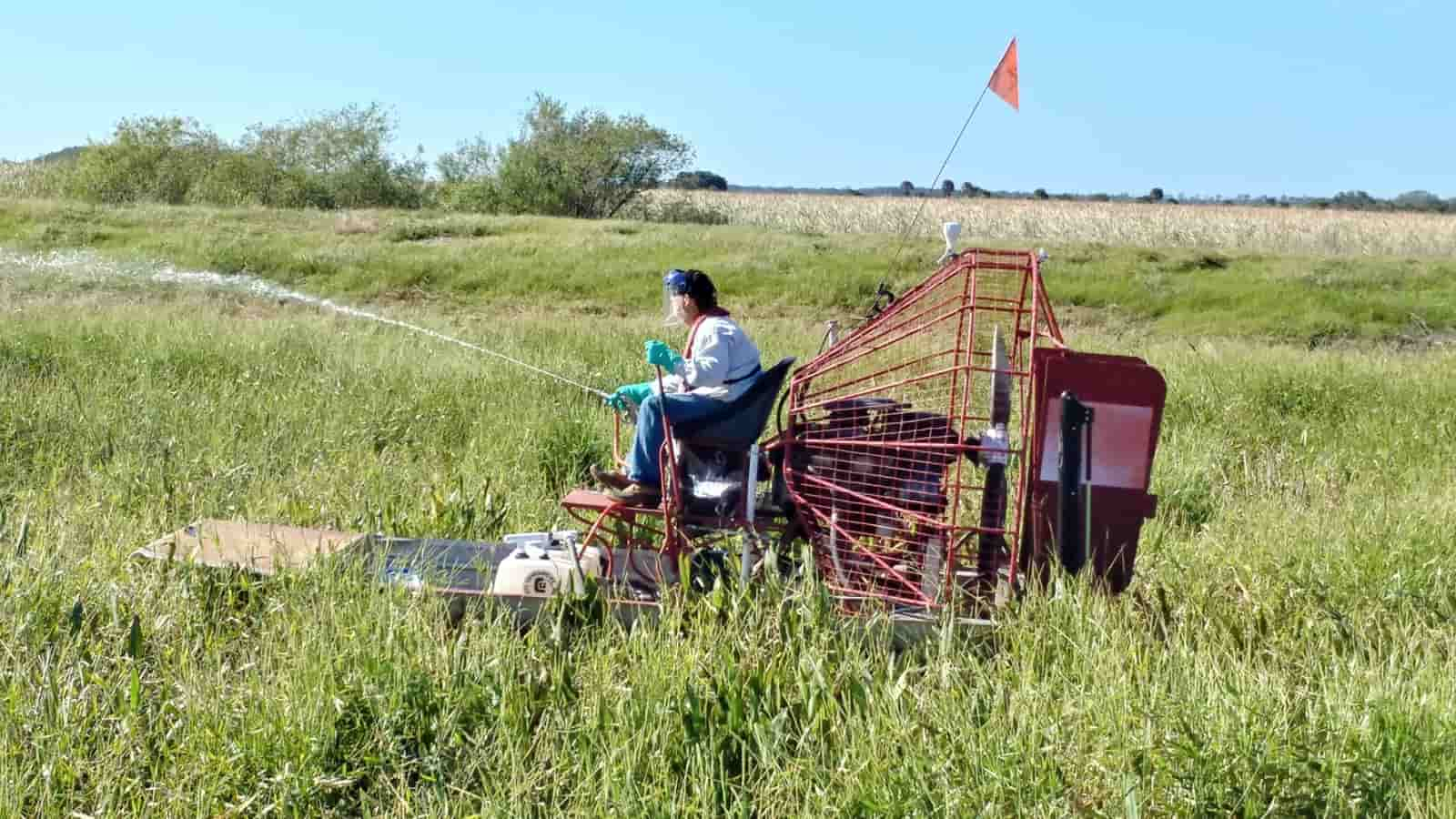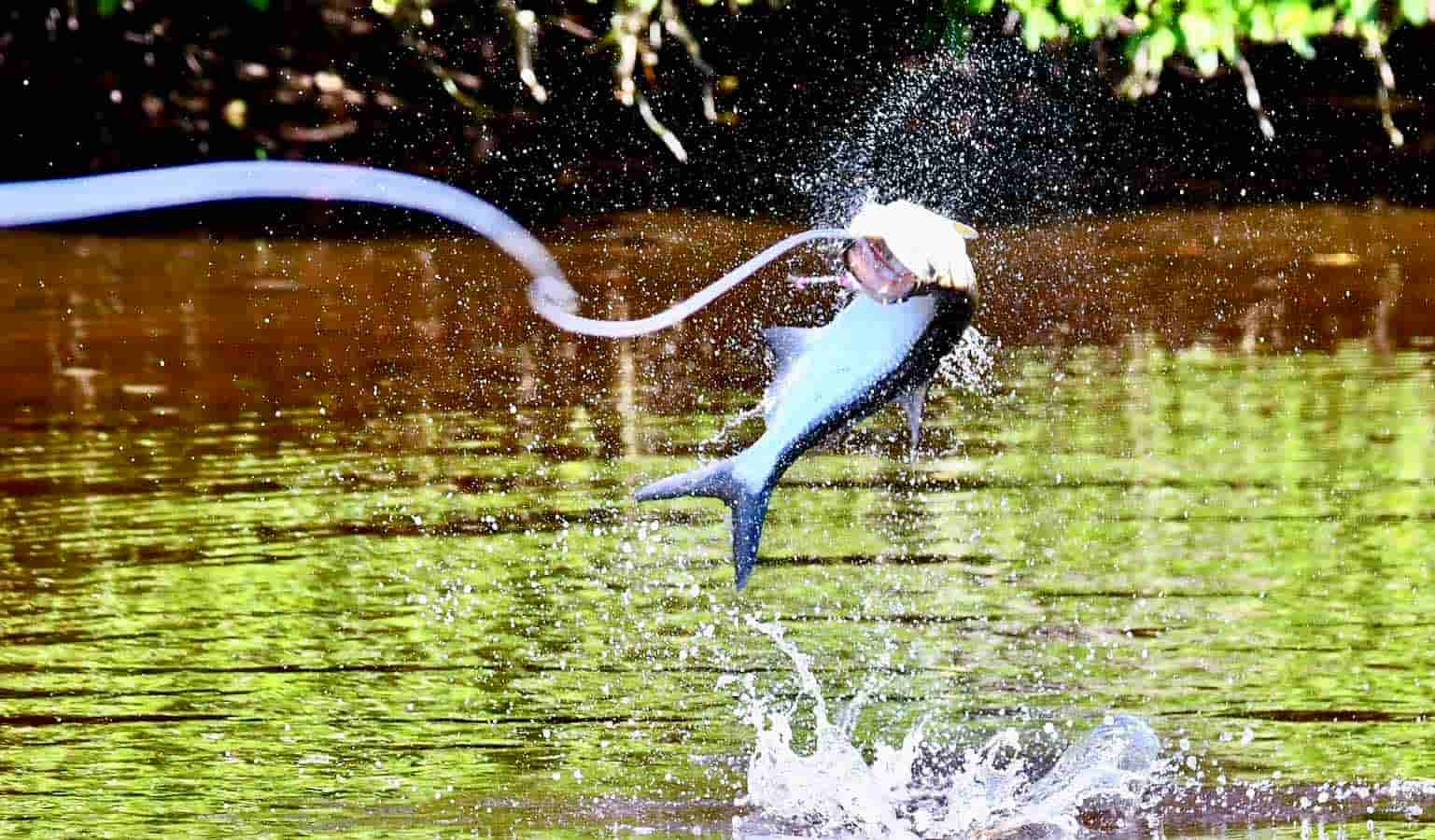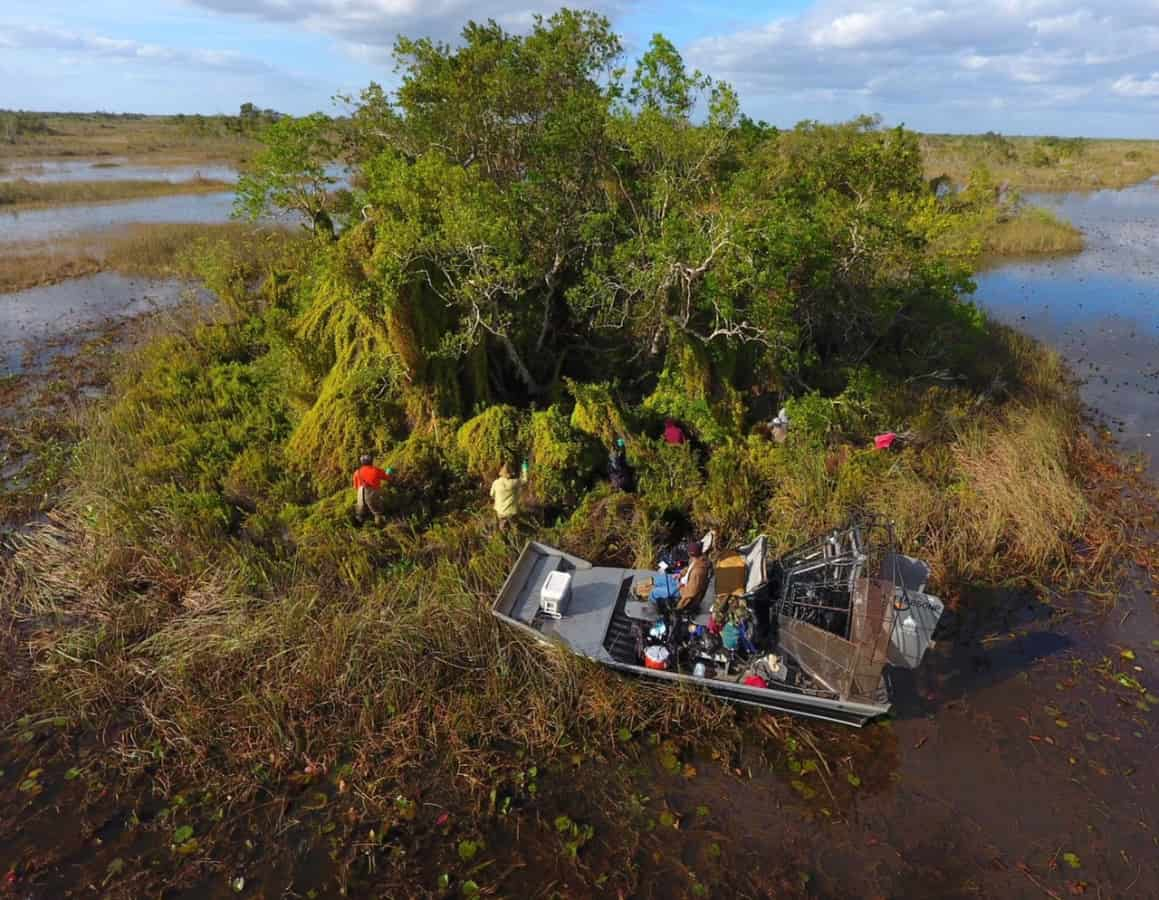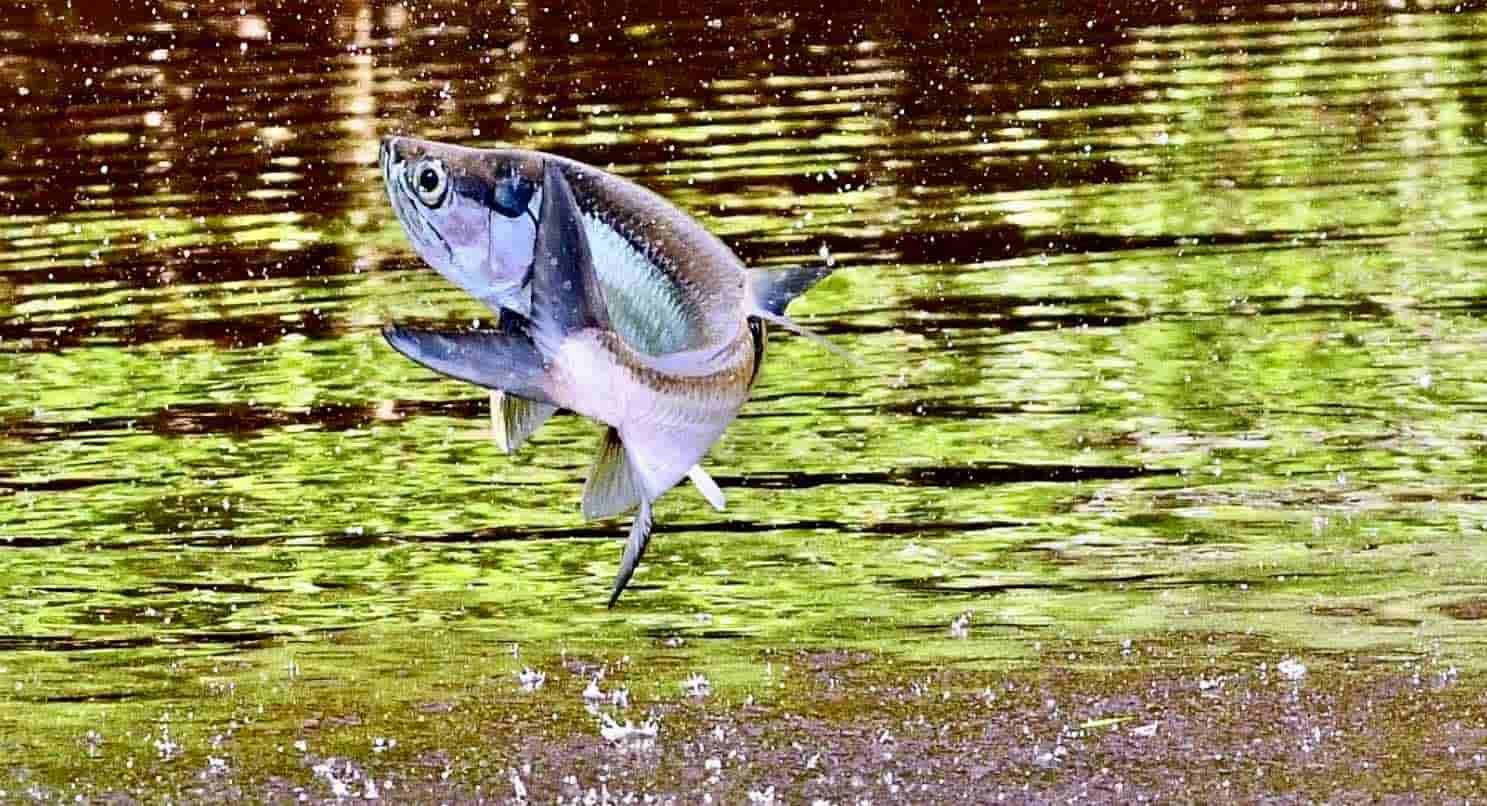Glyphosate Hysteria: Threat to Aquatic Ecosystems or Concocted Controversy

Airboat applicator treating an infestation of West Indian marsh grass on Florida’s Cypress Lake with glyphosate. ~ Photo by Dr. Stephen F. Enloe, University of Florida Agronomy Department/Center for Aquatic and Invasive Plants
The fiction concocted by lawyers that the herbicide glyphosate (active ingredient in Roundup) is a carcinogenic, DDT-like scourge has created a funding bonanza for fringe activist outfits. Among these are the Environmental Working Group, EcoWatch, Greenpeace, Center for Biological Diversity, U.S. Public Interest Research Group, and, as of November 2023, the Bonefish and Tarpon Trust (BTT).
You’ve seen the blitz of ads on TV and social media claiming a “link” between glyphosate and cancer: “Have you been exposed to Roundup? You may be entitled to major settlement money from Bayer. Call our law firm…”
That ad blitz issues from a 2018 California verdict, bereft of evidence and awarding major compensation to a cancer victim claiming to have been sickened by glyphosate.
Scientists—not lay-populated California juries—determine the safety of herbicides. And all scientific authorities on the planet that have done original research on glyphosate report no link to cancer. In fact, 18 of the world’s leading regulatory agencies, including the U.S. EPA, report no threat of any kind. What’s more, no herbicide may be labeled for use in the U.S. if it has more than one in a million chance of harming fish or any non-plant organism.
“LD50” stands for the lethal dose that kills half the test animals, so higher is safer. For rats, caffeine’s LD50 is 192 mg/kg, glyphosate’s 5,600. Glyphosate can’t bioaccumulate like DDT because it’s short-lived. It’s a plant poison only, inhibiting an enzyme plants need to make three amino acids. Fish and other animals don’t make this enzyme.
The Nature Conservancy (TNC), for example, uses 19 herbicides for restoring wildlife and fish habitat, glyphosate far more than the other 18. No herbicide is safer or more effective for such work.
But now, in a campaign entitled, “Win Back Our Water” — in partnership with the Ocean Research and Conservation Association (ORCA) — BTT calls for a ban on all uses of glyphosate, including by state, federal, and NGO fish and wildlife professionals. Such a ban would be a disaster for wildlife and fish, bonefish and tarpon included.

Photo by Capt. David Blinken
I love fishing for bonefish and tarpon, but I’ve been conflicted about my financial and editorial support for BTT. Bonefish and Tarpon are doing fine. There’s little commercial fishing anywhere, none in the U.S. or Bahamas. So what’s BTT’s mission? Research about spawning, migration, diseases, etc.? Yeah, I guess.
Particularly offensive is BTT’s manipulation of TV fishing show host Flip Pallot. In a BTT video Pallot echoes BTT’s glyphosate hysteria. My warnings to Flip that he’s being used went unanswered. Flip’s a heroic ambassador for ethical angling and fish conservation. But all he knows about glyphosate is what BTT tells him.
And BTT and ORCA are ill-informed, as I learned from my exchanges with BTT’s science and conservation director, Dr. Aaron Adams and ORCA’s science and education director, Missy Weiss.
Adams instructed that weed management should be “reexamined” in favor of “innovative approaches and mechanical removal.” And when I asked Weiss if there are legitimate uses of glyphosate she said, “I don’t know other than there’s lots of controversy.” Indeed there is, all based on junk science and resulting lawyer and media hype.
Bio-control is used where possible, but “innovative approaches” for most large infestations don’t exist. And, while mechanical removal is always preferable to herbicides, there isn’t enough heavy equipment on earth to control the 1,400 invasive plants blighting Florida. Mechanical removal doesn’t work on many species anyway.
“Sure, it’s always better to use non-toxic alternatives, if they’re practicable,” said Dan Ashe, who directed the U.S. Fish and Wildlife Service under Obama. “Often, however, they’re simply not. For instance, it would have been possible to hand-pull the head-high invasive verbesina from the ground at Midway Atoll National Wildlife Refuge, but it would have taken time and personnel that were simply not available. Use of herbicides like Roundup can accelerate the work, creating urgently needed nesting space for thousands of albatrosses.”
Florida TNC’s Kristina Serbesoff-King offers this: “When a water body gets choked with non-native vegetation, that vegetation dies. The huge amount of decaying biomass takes out oxygen. That kills fish.”

A tree island in the Everglades being freed from the clutches of invasive Old World climbing fern by machetes and glyphosate. ~ Photo by Jonathan Glueckert/University of Florida
When I toured Lake Okeechobee by airboat with biologist Don Fox of the Florida Fish and Wildlife Conservation Commission, I inspected a wide, half-mile-long swath of withered cattails sprayed with glyphosate by Fox. No mechanical device could have removed it.
Cattails are native, but the deluge of phosphorus from dairy farms and ag land renders them invasive. “They’re good guys gone bad,” said Fox. “If we didn’t use glyphosate, cattails would crowd out non-invasive, native vegetation, and organic sediments would build up, causing anaerobic conditions. We’d lose our invertebrate communities, and that would magnify up to forage fishes and game fishes.”
Old World climbing fern smothers Florida’s “tree islands,” critical habitat for all manner of wildlife from raptors to waterfowl to otters to deer to marsh rabbits. Mechanical removal isn’t possible. But when tree islands are sprayed with glyphosate by the South Florida Water Management District they recover spectacularly.
“Our goal is getting weeds down to maintenance mode so we can deal with small patches and apply small amounts of herbicide,” said the District’s lead scientist, LeRoy Rodgers. “Herbicides are a necessary tool, but we use them judiciously and only those approved by EPA for aquatic use. They have very low eco-toxical profiles and break down quickly.”
On January 28, 2019, Florida imposed a moratorium on all aquatic herbicides—this in response to glyphosate hysteria created by an online petition entitled “Stop the State-sanctioned Poisoning of Our Lakes and Rivers” and illustrated with a metal drum photo-shopped with a Jolly Roger beside dead fish which glyphosate hadn’t killed and couldn’t kill.
The moratorium horrified TNC, the Audubon Society, the Florida Fish and Wildlife Conservation Commission, the South Florida Water Management District, and other organizations working to protect aquatic life. On March 4, 2019 they got the moratorium lifted.
“In 1986, Florida also had a herbicide moratorium,” said Rodgers. “And in a few short months, our lakes and flowways were choked with exotic plants. We had to use triple the amount of herbicide we’d used at maintenance mode. It’s unfortunate that people without an understanding of weed management jump to conclusions and miss the big picture.”
Glyphosate effectively kills giant salvinia, infesting Florida and other southern states. This free-floating, duckweed-like fern is deadly to fish. “It just explodes,” reported Dr. Wes Neal of Mississippi State University’s Extension Service. “If not sprayed, it takes over, shading out sunlight, depleting oxygen, and killing fish.” Mechanical removal doesn’t work because pieces generate new plants.
Phragmites destroys fish habitat inland and on all three coasts. In Utah, for instance, it has devastated populations of the federally endangered June sucker and destroyed nursery and spawning habitat of pike, black bass, and panfish.
Removing all but tiny infestations of phragmites mechanically is impossible because the roots run so deep. Glyphosate is usually the herbicide of choice. Phragmites still chokes parts of 95,000-acre Utah Lake, but the state has reduced it by 74 percent. This from Aaron Eagar, Utah’s noxious weed program manager: “In the 1950s phragmites wasn’t there. We’ve treated it with Rodeo [glyphosate], and we’ve brought back lots of natives and opened up areas for fish and fishing.”
Floodplain trees produce seeds in spring, refueling countless bird species exhausted from migration. That’s why migrants follow river corridors north.
But floodplain forests are endangered. American elm, the oldest and most important floodplain component, has been devastated by Dutch elm disease. TNC is planting disease-resistant elms and other endangered wetland species. First, however, it must eradicate alien vegetation that would otherwise shade out seedlings. The only option is glyphosate.
I saw the results at the Silvio Conte National Wildlife Refuge beside the Connecticut River in Massachusetts. Along with the planted elms, native forbs, grasses, and wildflowers proliferated. Nectaring on new blossoms were hummingbirds, bees, and butterflies. Kingbirds hawked insects, goldfinches gorged on thistle seeds.

The Nature Conservancy, which uses glyphosate far more than any of the other 18 herbicides it depends on for fish and wildlife recovery, sprays glyphosate on alien phragmites in the Adirondacks. ~ Photo by Zack Simek
What brought on the California glyphosate verdict and resulting feeding frenzy for settlement money? Junk science from the International Agency for Research on Cancer (IARC), enfant terrible of the World Health Organization and with which WHO disagrees. Never has IARC done original research on glyphosate, but in 2015 it stuck glyphosate on its list of “probably carcinogenic” substances. Right up there with glyphosate on that list are “red meat” and “hot beverages.”
“IARC’s review [of existing studies] was such a crooked scam,” declared Dr. Lee Van Wychen, executive director of science policy for the National and Regional Weed Science Societies, “I’ve never seen anything like it… IARC cherry-picked a couple studies and on top of that fudged the results of those studies. They did these odds-ratio calculations—a correlation, not even a mechanistic cause — of how glyphosate might cause cancer. Now there are people on the conservation side who are afraid to use glyphosate.”
On Oct. 19, 2017 Reuters reported that IARC “dismissed and edited findings from a draft of its review of the weed killer glyphosate that were at odds with its final conclusion.”
The week IARC published its outlying opinion Christopher Portier, special adviser on IARC’s review, signed on as a litigation consultant for counsel suing Monsanto (now part of Bayer) on behalf of alleged glyphosate cancer victims. He reportedly got $450 per hour.
California responded to IARC’s review by ordering that all glyphosate products carry a cancer warning. But a federal judge struck down the requirement, ruling it “inherently misleading … when apparently all other regulatory and governmental bodies have found the opposite.”

Photo by Capt. David Blinken
Based on its partner’s findings, BTT proclaims that glyphosate is “impacting our fisheries.” But ORCA states it doesn’t know if there’s an impact. ORCA’s average glyphosate water reading in Indian River, St. Lucie, Brevard, Martin Counties (excluding a single sample of 1,410 parts per billion) was 3.25 ppb. The average in ORCA’s 320 fish samples was 0.29 ppb. EPA’s safe limit for glyphosate in drinking water is 700 ppb.
The only known “impact” is beneficial — the smorgasbord of forage fish, and invertebrates that breed upstream and are saved by glyphosate from getting choked to death by Florida’s plague of invasive aquatic plants.
If ORCA sampled 320 humans, it would doubtless get similar glyphosate readings. These are harmless traces of a benign substance measured in fractions of a ppb.
Fringe activist outfits make hay by reporting such traces in breakfast cereals. That’s because glyphosate is by far the most effective, safest and therefore most widely used herbicide in the world. Is it overused by farmers? Sure. Never is it overused by fish and wildlife professionals.
If BTT doesn’t like herbicides, why target the safest and most essential for fish and wildlife recovery? Might it be that all the lawyer and media hype issuing from IARC’s junk science has panicked the public, creating low-hanging funding fruit?
If BTT and allies succeed in banning glyphosate, farmers will switch to some other registered herbicide. And whatever that is, it will be more dangerous. One likely alternative is Dicamba. Unlike glyphosate, it drifts long distances when misused (as it often is). In 2018 Dicamba wiped out hundreds of non-target farms in the Midwest.
Adams’ last response to me was: “Thanks for your concern… We agree that aquatic and other invasive weeds pose a management challenge, and that glyphosate (and to a lesser extent other herbicides) can be tools in the larger toolbox under appropriate circumstances.”
Well, no. BTT agrees to no such thing. It’s currently circulating a petition (linked to “funding options”) entitled “Stop Glyphosate.” The petition calls on “federal, state and local agencies” to “eventually eliminate the use of harmful glyphosate throughout Florida.”
Editor’s note: Look for a followup piece on the use of glyphosate for conservation purposes, including an interview with a Bonefish and Tarpon Trust representative, next week in MidCurrent.











